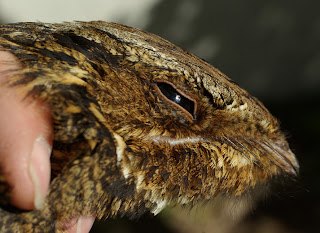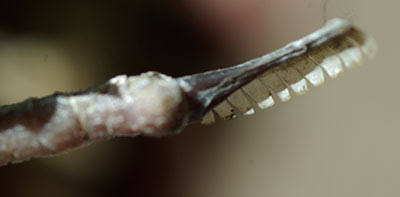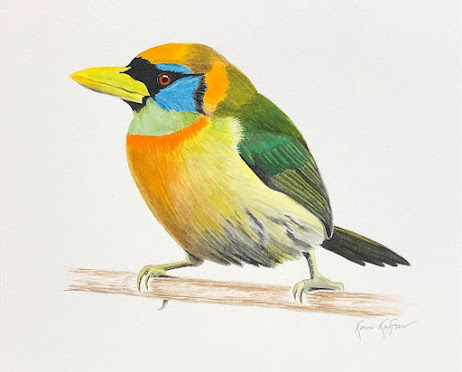Bird Research - Point // Counterpoint
Kimberly Writes: I've received a tremendous amount of feedback on my last post about bird research. I wanted to share a particular comment, because I think the points are so valuable. The following comment was made by by "Jude," and I thought it was important enough to share openly on our blog in order to generate some good, healthy dialogue about this subject.
The comment from Jude:
"I don't know the birder who sparked your response, but I'd be very surprised if their call to re-examine banding came from a place of not understanding the critical importance of the data being gathered. As a novice birder, I've already seen distressing examples of geese with overly tight neck bands, smaller birds with too tight leg bands, and birds with too many bands altogether. I imagine you have to have seen way more than I. Understanding the value of data gathering in conservation efforts and advocacy can and should be accompanied by compassion and a very high standard of performance for the practices that allow the data-gathering to happen. There is nothing wrong and everything right about not remaining complacent about the data-gathering practices currently in place. Wanting to lessen the impact of banding/collaring/etc. on individual animals increases the quality of the data returned and has nothing to do with not understanding that there are always trade-offs and imperfect decisions to be made in approaches."
Truth is, Jude, that if I had been responding to just one comment put in the context that you describe, my thoughts would have been different. I wholeheartedly agree that all methods of research on / with animals should be constantly, carefully, critically, monitored and reevaluated to ensure the safety of both the animals and the volunteers these projects frequently rely on.
In my blog post, I was responding specifically to those who make sweeping statements about how banding (and other methods of tracking / tagging birds) is bad, based solely on emotion, without any thought to the value of the data these studies provide. If there were any scientific evidence to back up the idea that these methods do more harm than good, I assure you that it would be considered very seriously.
R
Rather than just let this balance on my opinion (even though my thoughts are based on years of actually conducting these kinds of studies, and also, I might add, being a soft-hearted animal lover, too), I thought it would be good to provide some additional insight.
In a recent issue of The Wildlife Professional, the journal of The Wildlife Society, they offered the opportunity to discuss the value of continuing to band birds in the [Point // Counterpoint] column. Marlene Condon, a natural-history writer and photographer, took up one position, commenting that. "At a time when nearly a third of the 800 bird species in the United States are threatened or in decline (The state of the Birds 2009), scientists should ask themselves: Is banding worth the stress it places on birds?"
Taking up the alternate view was Bruce G. Peterjohn, Chief of the Bird Banding Labaratory at the USGS Patuxtent Wildlife Research Center in Maryland. Bruce stated, "Despite the obvious benefits of bird banding, the practice has its critics. Recent studies show that most annual mortality in bird populations occurs during migration (Sillett and Holmes 2002). Some critics fear that migratory birds may be imperiled by carring a band, which typically weighs less than 1 percent of the total body weight. Yet that claim has never been substantiated."
Read the [Point // Counterpoint] in its entirety, HERE.
Any bird bander who's used mist nets was eager to learn the findings of a recent study on the threats of mist netting to birds. When the findings were released, bird banders were sincerely thankful to have this burning question answered with sound scientific answers.
The research, led by Erica Spotswood from the University of California at Berkeley, used data from organizations across the United States and Canada to assess the risk factors which could increase rates of injury or mortality including bird size, age, frequency of capture and the role of predators.
The results revealed that birds are rarely injured or killed by mist nets. Of 620,997 captures the percentage of incidents of injury amounting to 0.59% while only 0.23% of captures resulted in mortality. The authors then began to analyse risk factors which could lead to increased incidents. Read more about the study, HERE.
Watching birds: studying them through optics, or simply using the bird watching tools built conveniently into our own heads, will never go out of style or be replaced by mist nets, bands, neck collars, radio telemetry, or color-marking.
 There will always be incredible value to the power of bird observation. If for nothing more than the way it enriches our lives- which leads to a deeper level of understanding - and ultimately, to a deeper level of caring and commitment to support bird conservation. There is room on the bird boat for everyone who wants the habitat that birds depend on to be here for generations to come.
There will always be incredible value to the power of bird observation. If for nothing more than the way it enriches our lives- which leads to a deeper level of understanding - and ultimately, to a deeper level of caring and commitment to support bird conservation. There is room on the bird boat for everyone who wants the habitat that birds depend on to be here for generations to come.
The comment from Jude:
"I don't know the birder who sparked your response, but I'd be very surprised if their call to re-examine banding came from a place of not understanding the critical importance of the data being gathered. As a novice birder, I've already seen distressing examples of geese with overly tight neck bands, smaller birds with too tight leg bands, and birds with too many bands altogether. I imagine you have to have seen way more than I. Understanding the value of data gathering in conservation efforts and advocacy can and should be accompanied by compassion and a very high standard of performance for the practices that allow the data-gathering to happen. There is nothing wrong and everything right about not remaining complacent about the data-gathering practices currently in place. Wanting to lessen the impact of banding/collaring/etc. on individual animals increases the quality of the data returned and has nothing to do with not understanding that there are always trade-offs and imperfect decisions to be made in approaches."
Truth is, Jude, that if I had been responding to just one comment put in the context that you describe, my thoughts would have been different. I wholeheartedly agree that all methods of research on / with animals should be constantly, carefully, critically, monitored and reevaluated to ensure the safety of both the animals and the volunteers these projects frequently rely on.
In my blog post, I was responding specifically to those who make sweeping statements about how banding (and other methods of tracking / tagging birds) is bad, based solely on emotion, without any thought to the value of the data these studies provide. If there were any scientific evidence to back up the idea that these methods do more harm than good, I assure you that it would be considered very seriously.
 |
| Check out the rictal bristles around the bill on this Chuck-Will's-Widow. Can you believe those are actually feathers?! |
 |
| ---and its specially adapted rear toe for cleaning the rictal bristles. |
Rather than just let this balance on my opinion (even though my thoughts are based on years of actually conducting these kinds of studies, and also, I might add, being a soft-hearted animal lover, too), I thought it would be good to provide some additional insight.
In a recent issue of The Wildlife Professional, the journal of The Wildlife Society, they offered the opportunity to discuss the value of continuing to band birds in the [Point // Counterpoint] column. Marlene Condon, a natural-history writer and photographer, took up one position, commenting that. "At a time when nearly a third of the 800 bird species in the United States are threatened or in decline (The state of the Birds 2009), scientists should ask themselves: Is banding worth the stress it places on birds?"
Taking up the alternate view was Bruce G. Peterjohn, Chief of the Bird Banding Labaratory at the USGS Patuxtent Wildlife Research Center in Maryland. Bruce stated, "Despite the obvious benefits of bird banding, the practice has its critics. Recent studies show that most annual mortality in bird populations occurs during migration (Sillett and Holmes 2002). Some critics fear that migratory birds may be imperiled by carring a band, which typically weighs less than 1 percent of the total body weight. Yet that claim has never been substantiated."
Read the [Point // Counterpoint] in its entirety, HERE.
Any bird bander who's used mist nets was eager to learn the findings of a recent study on the threats of mist netting to birds. When the findings were released, bird banders were sincerely thankful to have this burning question answered with sound scientific answers.
The research, led by Erica Spotswood from the University of California at Berkeley, used data from organizations across the United States and Canada to assess the risk factors which could increase rates of injury or mortality including bird size, age, frequency of capture and the role of predators.
The results revealed that birds are rarely injured or killed by mist nets. Of 620,997 captures the percentage of incidents of injury amounting to 0.59% while only 0.23% of captures resulted in mortality. The authors then began to analyse risk factors which could lead to increased incidents. Read more about the study, HERE.
Watching birds: studying them through optics, or simply using the bird watching tools built conveniently into our own heads, will never go out of style or be replaced by mist nets, bands, neck collars, radio telemetry, or color-marking.
 There will always be incredible value to the power of bird observation. If for nothing more than the way it enriches our lives- which leads to a deeper level of understanding - and ultimately, to a deeper level of caring and commitment to support bird conservation. There is room on the bird boat for everyone who wants the habitat that birds depend on to be here for generations to come.
There will always be incredible value to the power of bird observation. If for nothing more than the way it enriches our lives- which leads to a deeper level of understanding - and ultimately, to a deeper level of caring and commitment to support bird conservation. There is room on the bird boat for everyone who wants the habitat that birds depend on to be here for generations to come.



I am awestruck by that close shot of a Chuck wills Widows toe. What an amazing adaptation! On another note, nice treatise on banding.
ReplyDeleteThank you Kim.
ReplyDeleteI am so glad I found this blog. I have a fledgling bird blog of my own (www.playonbirds.wordpress.com), and I've been intimidated by many of the blogs I've seen with fancy pictures and loads of insider terminology. I find your blog to be refreshing in its humility. The photos and narrative tell a story, rather than show off fancy photography (although your photography is nothing to laugh at!). Imagine my surprise when I realized that this blog is associated with Kenn Kaufman of Kingbird Highway fame! You are a charming husband and wife team. As a young woman engaged to a bird enthusiast, the Kaufmans are an inspiration. Thank you! P.S. I love the photos of the children holding the birds. I'm a bilingual elementary teacher, and my greatest joy is sharing natural beauty with my urban students.
ReplyDelete